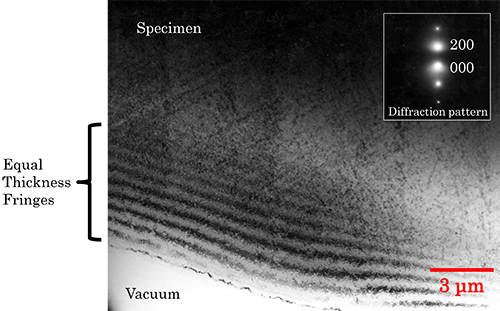等厚干渉縞
等厚干渉縞
equal thickness fringe
[目次:理論(電子の散乱/回折/結像)]
曲がりのないくさび形の結晶性試料でひとつの回折波をブラッグ条件に合わせた場合、明視野像および暗視野像に厚さの変化にしたがって周期的に変わる縞模様が現れる。これを等厚干渉縞という。縞ができる原因は、二波近似動力学的回折効果によって、透過波および回折波に波長が僅かに異なる二つの波が作られ、それらが干渉して唸りを起こすからである。二つの縞の間での厚さ変化(消衰距離)は回折波の結晶構造因子の逆数に比例する。等厚干渉縞は試料の厚さの推定に使われる。また、結晶構造因子が試料の組成によって変化するので、半導体多層膜での組成変化の解析に利用される。
equal thickness fringe⇒図
AlCu合金で200反射を励起した場合の明視野像。加速電圧: 200 kV。
試料は楔状になっていて、像下部の真空側から奥(上側)に向かって厚さが増している。厚さの変化に対応した等厚干渉縞が観察されている。
When one diffracted wave is matched to the Bragg condition in a wedge-shaped crystalline specimen with a constant orientation, both the bright-filed image and dark-field image of this specimen exhibit periodic fringes depending on the change of the thickness. This pattern is termed (equal) thickness fringes. Two beams whose wavelengths are slightly different are formed in the transmitted wave and the diffracted wave due to the two-beam dynamical diffraction effect. They interfere with each other to cause beats or thickness fringes. The thickness change between the neighboring fringes (extinction distance) is proportional to the reciprocal of the crystal structure factor of the diffracted wave. The fringes are used for the estimation of the specimen thickness. The composition change of a multilayer semiconductor film can be measured from the difference of the extinction distances because the value of the crystal structure factor depends on the composition of each layer.

Bright-field image of an AlCu alloy taken at an accelerating voltage of 200 kV, where 200 reflection is excited.
The AlCu specimen is wedge-shaped and its thickness increases toward a far direction (upward in the image) from the vacuum side (left bottom of the image). Equal thickness fringes exhibiting thickness changes are seen.
関連用語から探す
説明に「等厚干渉縞」が含まれている用語






